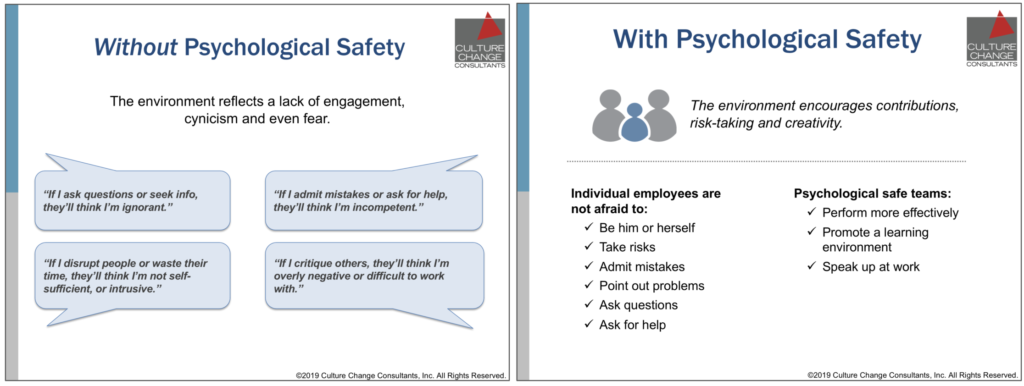Creating a Work Culture of Psychological Safety: Making it Safe to Speak Up
Psychological Safety (PS) is best defined as a climate in which members of a team or organization feel safe enough to speak up about problems, raise important questions, point out hazardous conditions, confront negative behaviors or bring forth new ideas and solutions.
The impact of psychological safety on safety performance is immense. Hi-PS organizations regularly and effectively tap employee expertise for safety improvement ideas. Lo-PS organizations, on the other hand, discourage or even suppress employee contributions and concerns. Without psychological safety, fear can – and often does –prevent employees from voicing concerns or surfacing potential problems and as a result, many safety issues are never noted nor fixed. Organizations can point to incident investigations based upon sophisticated root cause analysis protocols, but until all employees feel safe to speak up, the organization will operate in a state of data darkness.

Front-line workers, managers and safety professionals get it! They all understand that you can’t have physical safety without psychological safety. What they don’t know is how to change gears: how to stop operating as a lo-PS organization and start thriving as a hi-PS organization.
How do you nurture psychological safety so that all employees feel safe to speak up? The psychological safety of an organization is comprised of four major components: the Individual, the Team, the Leadership, and the Culture. All four must be taken into account in order to create and sustain an organizational shift from lo-PS to hi-PS.

The first step is to analyze how each of the four components impacts psychological safety within the framework of your unique organization. Then, based on the results of your analysis, the second step is to select targeted tools and interventions that have been proven to advance psychological safety. Finally, the third step is to develop a Psychological Safety Roadmap™ that will clearly define and chart the course to cultivate conditions for improved trust within your organization.
Creating a work culture where employees feel safe to speak up isn’t simple and it doesn’t happen overnight. But it is unquestionably worth the effort once the benefits of a hi-PS organization begin to emerge in the form of employee contributions that improve – and in some cases transform – their teams or workplace.
For the past three decades, Dr. Steven I. Simon has worked with leadership groups and grassroots safety teams in many Fortune 100 and Fortune 500 companies to establish cultural norms that create psychological safety in the workplace. Dr. Simon’s firm, Culture Change Consultants, is the pioneer and leader in creating and transforming safety cultures across the globe.
To learn more about psychological safety and how to foster it in your team or organization, visit our website at www.culturechange.com.
